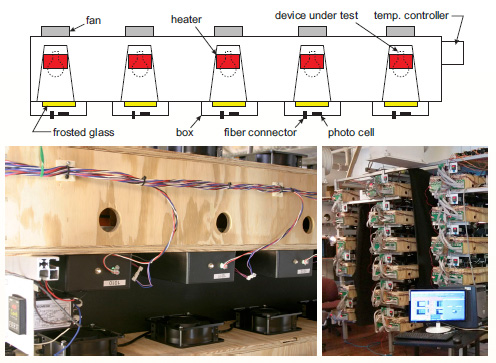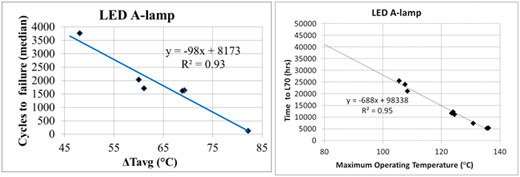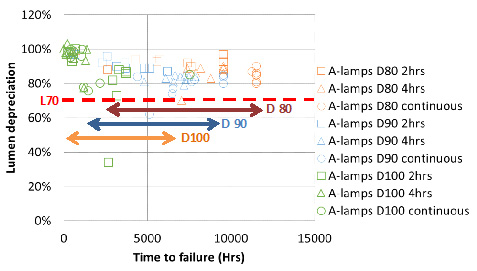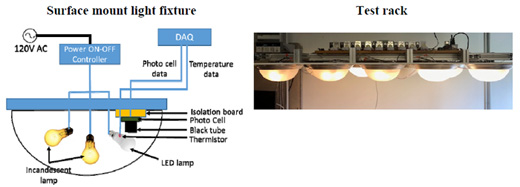Developing a Predictive Life Test for LED Systems
 |
Literature Summary of Lifetime Testing of Light Emitting Diodes and LED Products (2021)
Download new report from the LRC and IEA 4E Solid State Lighting Annex on life testing methods for LED lighting products
|
Introduction
The life of an LED lighting system is dependent upon numerous factors and components, including operating temperature, on-off cycling, thermal management systems, luminaire housing and packaging optics, and driver components, not to mention the LEDs themselves. The failure of any component can cause the whole system to fail. Presently, LED lighting product life is rated based upon the lumen maintenance of the LEDs (IESNA LM80/TM21), but this method cannot predict the catastrophic failure of a system.
In 2009, the LRC began investigating the life of LED lighting systems in order to develop an accelerated, predictive life-test procedure that accounts for both useful life and the possibility of catastrophic failure of a system at any given environment temperature and use pattern. This research and the final results are described below.
Preliminary Studies
LRC researchers began with a preliminary study, funded by ASSIST, to understand the effects of different delta temperatures (the temperature change during the on-off cycle) and dwell times (the duration the system is operating at its maximum steady-state temperature) on LED system time to failure. The lighting system selected for this study was an LED-based incandescent lamp replacement. Results showed the dominant failure mode to be solder joint failure. When the delta temperature increased, the system failed in a shorter time and showed faster lumen depreciation. Even though the dwell time increase showed a longer time to failure, at the highest delta temperature used in this study the trend was not the same at lower temperatures.
One present standard (IES LM-84) offers a first attempt toward a system life test but is based upon continuous operation rather than typical on-off lighting use patterns. Further study under ASSIST funding showed that no catastrophic failures happened with systems tested while continuously on for 5,000 hours; however, when power was cycled, all samples of similar system type failed within 4500 hours.
|
ASSIST 2013 preliminary study of system life |
Long-term Laboratory Studies
In 2014, the Bonneville Power Administration and the New York State Energy Research and Development Authority provided co-funding to expand the preliminary studies to include more types and samples of LED luminaires, lamps and light engines. Objectives for the two-year project included:
• To further validate the test method proposed in the previous LRC studies and the observed results
• To estimate color shift at projected end of life
• To develop a cost-effective, accelerated test method for accurate determination of whole system life at any given environment temperature and use pattern
• To move the testing method forward toward industry adoption
The selected LED products for test included a 16W integral A-lamp (75W equivalent), an 8W MR16 lamp (50W equivalent), and a 14W downlight fixture (75W equivalent).

Individual test chamber design with five product samples in each box. The setup controlled the lighting system temperature and on-off cycles accurately while continuously monitoring the light output, LED system temperature, and power input of each product. The spectral power distribution of each product was measured at regular intervals. Racks housed the 270 LED product samples and the computer controlled data acquisition system.
The study results showed for the LED A-lamps tested, both catastrophic and parametric failure types exist. On-off cycling encourages catastrophic failure and maximum operating temperature influences the lumen depreciation rate and parametric failure time. On-off switching results in catastrophic failure because of the stresses experienced by the interface material due to thermal expansion mismatch between the different layers in the system that lead to fatigue failure. Parametric failures such as lumen depreciation and color shift are caused by the yellowing of the binding materials used in the LED packages to hold the phosphor particles. Such failures become rapid at higher temperatures. Therefore, transitions taking place during on-off cycling encourage catastrophic failure, and LED device operation at maximum temperature accelerates parametric failure.
For manufacturer reporting, the shorter of the two times to failure should be considered as the lifetime of the product because in applications, LED systems will experience both types of failure and depending on the conditions, one failure type could dominate. For the lamps tested, catastrophic failure times were shorter than lumen depreciation (L70) failure times. The results from this study show that to obtain more accurate life estimates of LED systems, unlike current industry test standards and practices, life testing must include on-off switching.
From the results of this study and from earlier studies, we are encouraged that a test procedure can be developed to accurately predict LED system life in any application by testing the whole LED system, including on-off power cycling with sufficient dwell time, and considering both failure types, catastrophic and parametric.

Left: Cycles to failure as a function delta time-averaged temperature (ΔT avg). Right:
Time to failure due to lumen depreciation, L70, as a function of maximum operating temperature.*

Lumen depreciation values of tested lamps just prior to catastrophic failure.*
* Narendran et al. 2016. Projecting LED product life based on application. Proc. SPIE 9954: 99540G.
Development of an Alternative, Low-cost Test Setup
Following the long-term life-test study, a follow-up study was conducted in 2016 to develop a low-cost test setup as an alternative to the laboratory setup used for the experimental study. Another objective for this alternative setup was to determine if a shorter testing time could produce an accurate system life estimate. The test setup was designed to use a three-lamp surface mount light fixture that can house an LED replacement A-lamp (60W incandescent equivalent) and two incandescent A-lamps of different wattages (25W/40W/60W) to create the necessary delta temperatures to stress the LED lamp. A power on-off controller was used to achieve the necessary dwell time.

Lower cost experiment setup for life testing LED A-lamps
.**
Results from this lower cost experiment setup were similar to those of the previous studies, where cycles to failure (median life) and delta time-averaged temperature have an inverse linear relationship with goodness-of-fit, R2 = 0.99. Addtionally, L70 time to parametric failure (median life) as a function of maximum operating temperature also showed an inverse linear relationship with goodness-of-fit, R2 =0.99. With 4 hours (3 hours on, 1 hour off) per cycle, the total test time required is less than 1500 hours.
** Narendran et al. 2017. Predicting LED system life: A long-term study of the factors that determine performance and failure. Proceedings of the IES 2017 Annual Conference.
Technical Reports, Presentations and Publications
De Vas Gunawardena, S., A. Udage, I.U. Perera, and N. Narendran. 2022. Investigating current and temperature dependencies of UV-A light-emitting diodes. 2022 IES Annual Conference, August 18-20, New Orleans, LA.
IEA 4E Solid State Lighting Annex. 2021. Literature Summary of Lifetime Testing of Light Emitting Diodes and LED Products. Prepared by the Lighting Research Center, June 4, 2021.
Narendran, N., J.P. Freyssinier, I. Perera and J. Taylor. 2021. Two techniques: Identifying methods to better estimate LED product lifetime. LD+A: Lighting Design & Application, November 2021, pp. 22–24.
Perera, I.U., N. Narendran, A. Udage, S. De Vas Gunawardena, and J.P. Freyssinier. 2021. Photosensor long-term performance study. IES 2021 Virtual Annual Conference, August 9-13, 2021.
ASSIST. 2020. ASSIST recommends...Recommendations for testing LED lighting systems and projecting system lifetime in different applications. Vol. 14, Iss. 1. Troy, N.Y.: Lighting Research Center.
Narendran, N., E. Page, and C. Miller. 2018. LED lighting product life and failure: Why we need new test methods for accurate life reporting in applications. Lightfair International 2018, May 10, 2018, Chicago, Illinois.
Narendran, N., Y. Liu, X. Mou, and D.R. Thotagamuwa. 2017. Predicting LED system life: A long-term study of the factors that determine performance and failure. Proceedings of the IES 2017 Annual Conference, August 10-12, Portland, Oregon.
Narendran, N. 2017. How long will it last? Predicting LED system life based on the application. Strategies in Light 2017, February 28-March 2, Anaheim, CA.
The National Academies of Sciences, Engineering and Medicine. 2017. Assessment of Solid-State Lighting, Phase 2. Washington DC: The National Academies Press.
Development of a Predictive Life Test Method for LED Luminaires, Light Engines, and Integral Lamps – Final project report, December 2016, sponsored by Bonneville Power Administration (BPA TIP 322), New York State Energy Research and Development Authority (NYSERDA Agreement No. 46905), and Alliance for Solid State Illumination Systems and Technologies (ASSIST).
Narendran, N., Y. Liu, X. Mou, D.R. Thotagamuwa, and O.V. Madihe Eshwarage. 2016. Projecting LED product life based on application. Proceedings of SPIE 9954, Fifteenth International Conference on Solid State Lighting and LED-based Illumination Systems, 99540G (September 14, 2016); doi: 10.1117/12.2240464.
Narendran, N. 2016. A short-duration LED system life test. EPA Energy Star Lighting Webinar Series: The Quest for a Short Term Reliability Test, September 29, 2016.
Energy Star Lighting Webinar Series
Narendran, N., and Y. Liu. 2015. LED life versus LED system life. In:
SID ‘15 Digest of Technical Papers, paper 62-2, SID Display Week 2015: International Symposium, Seminar and Exhibition, May 31-June 5, San Jose, CA.
Narendran, N. 2015. Solid-state lighting: What is new in research? IES Toronto Chapter, April 15, Toronto, ON, Canada.
Narendran, N. 2014. An accelerated test method for estimating LED system life. 9th SSL Annex Expert Meeting, October 2014, Portland, OR.
Narendran, N. 2014. An accelerated test method for estimating LED system life. 14th International Symposium on the Science and Technology of Lighting (LS14), June 22-27, Como, Italy.
Narendran, N. 2014. Accelerated life-testing study to predict LED system failure. Strategies in Light 2014, February 25-27, Santa Clara, CA.
Jayawardena, A., D. Marcus, X. Prugue, and N. Narendran. 2013. Long-term lumen depreciation behavior and failure modes of multi-die array LEDs. Proceedings of SPIE 8835: 883510.
Han, L., and N. Narendran. 2009. Developing an accelerated life test method for LED drivers. Ninth International Conference on Solid State Lighting, August 3-5, 2009, San Diego, Proceedings of SPIE 7422: 742209.
Summary | Full-text PDF 
Narendran, N., Y. Gu, L. Jayasinghe, J.P. Freyssinier, and Y. Zhu. 2007. Long-term performance of white LEDs and systems. Proceeding of First International Conference on White LEDs and Solid State Lighting, Tokyo, Japan, November 26-30, 2007, P174–P179.
Full-text PDF 
Narendran, N. and Y. Gu. 2005. Life of LED-based white light sources. IEEE/OSA Journal of Display Technology 1(1): 167-171.
Full-text PDF 
ASSIST. 2005, 2007. ASSIST recommends: LED Life for General Lighting. Vol. 1, Iss. 1-7. Troy, N.Y.: Lighting Research Center.
Gu, Y., N. Narendran, and J.P. Freyssinier. 2004. White LED performance. Fourth International Conference on Solid State Lighting, Proceedings of SPIE 5530, eds. I.T. Ferguson, N. Narendran, S.P. DenBaars, J.C. Carrano, 119-124. Bellingham, WA: International Society of Optical Engineers.
Full-text PDF 
Hong, E., and N. Narendran. 2004. A method for projecting useful life of LED lighting systems. Third International Conference on Solid State Lighting, Proceedings of SPIE 5187: 93-99.
Summary | Full-text PDF 
Narendran, N., L. Deng, R.M. Pysar, Y. Gu, and H. Yu. 2004. Performance characteristics of high-power light-emitting diodes. Third International Conference on Solid State Lighting, Proceedings of SPIE 5187: 267-275.
Summary | Full-text PDF 
Narendran, N., Y. Gu, J.P. Freyssinier, H. Yu, and L. Deng. 2004. Solid-state lighting: Failure analysis of white LEDs. Journal of Crystal Growth 268 (3-4): 449-456.
Full-text PDF 
Narendran, N., N. Maliyagoda, A. Bierman, R. Pysar, and M. Overington. 2000. Characterizing white LEDs for general illumination applications. Proceedings of SPIE 3938: 240-248.
Full-text PDF
Media Coverage
De Vas Gunawardena, A.P.S. 2023. LED Driver Useful Life: New Research on Multiple Component Degradation and Their Effects on Driver Life. LD+A: Lighting Design & Application, May 2023.
Craven McGinty, J. 2021. Why LED bulbs don’t always live up to the hype about their life spans. The Wall Street Journal, Oct. 1, 2021. (subscription required)
Narendran, N. 2017. Industry test standards must evolve to ensure accurate LED system life estimates. LEDs Magazine, May/June 2017, pp. 23–24.
Jiao, J. 2017. Work continues on three LED lighting reliability standards. LEDs Magazine, May/June 2017.
Mullaney, R. 2017. 5 projects in 5 pages. LD+A, July 2017, pp. 47–52.
Project Summary Sheets
Predicting LED System Life under Real-World Conditions (2017) 
Developing a Predictive Life Test for LED Systems (2015) 
Sponsors
Bonneville Power Administration (TIP 322)
New York State Energy Research and Development Authority (Agreement 46905)
Alliance for Solid-State Illumination Systems and Technologies (ASSIST)
|


